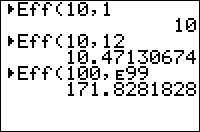TI-BASIC:Eff: Difference between revisions
Initial automated import |
Automated internal link correction |
||
| (One intermediate revision by one other user not shown) | |||
| Line 26: | Line 26: | ||
The formula for converting from a nominal rate to an effective rate is: | The formula for converting from a nominal rate to an effective rate is: | ||
<math> | |||
\definecolor{darkgreen}{rgb}{0.90,0.91,0.859}\pagecolor{darkgreen} | \definecolor{darkgreen}{rgb}{0.90,0.91,0.859}\pagecolor{darkgreen} | ||
\operatorname{Eff}=100\left(\left(1+\frac{\operatorname{Nom}}{100 \operatorname{CP}}\right)^{\operatorname{CP}}-1\right) | \operatorname{Eff}=100\left(\left(1+\frac{\operatorname{Nom}}{100 \operatorname{CP}}\right)^{\operatorname{CP}}-1\right) | ||
</math> | |||
Here, Eff is the effective rate, Nom is the nominal rate, and CP is the number of compounding periods. | Here, Eff is the effective rate, Nom is the nominal rate, and CP is the number of compounding periods. | ||
| Line 39: | Line 39: | ||
= Related Commands = | = Related Commands = | ||
* [[TI-BASIC: | * [[TI-BASIC:Nom|►Nom(]][[Category:TI-BASIC]] | ||
[[Category:TIBD]] | [[Category:TIBD]] | ||
Latest revision as of 23:55, 24 February 2016
Command Summary
Converts a nominal interest rate to an effective interest rate.
Command Syntax
►Eff(interest rate,compounding periods)
Menu Location
On the TI-83, press:
- 2nd FINANCE to access the finance menu.
- ALPHA C to select ►Eff(.
On the TI-83+ or higher, press:
- APPS to access the applications menu.
- ENTER or 1 to select Finance...
- ALPHA C to select ►Eff(.
TI-83/84/+/SE
2 bytes
The ►Eff( command converts from a nominal interest rate to an effective interest rate. In other words, it converts an interest rate that does not take into account compounding periods into one that does. The two arguments are 1) the interest rate and 2) the number of compounding periods.
For example, take an interest rate of 7.5% per year, compounded monthly. You can use ►Eff( to find out the actual percent of interest per year:
►Eff(7.5,12) 7.663259886
Formulas
The formula for converting from a nominal rate to an effective rate is:
<math> \definecolor{darkgreen}{rgb}{0.90,0.91,0.859}\pagecolor{darkgreen} \operatorname{Eff}=100\left(\left(1+\frac{\operatorname{Nom}}{100 \operatorname{CP}}\right)^{\operatorname{CP}}-1\right) </math>
Here, Eff is the effective rate, Nom is the nominal rate, and CP is the number of compounding periods.
Error Conditions
- ERR:DOMAIN is thrown if the number of compounding periods is not positive, or if the nominal rate is -100% or lower (an exception's made for the nominal rate if there is only one compounding period, since ►Eff(X,1)=X)
